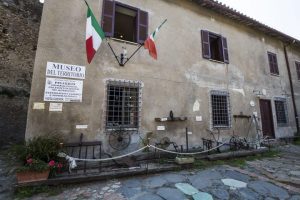
The Museum of the Territory is located inside the Castle of Santa Severa and documents the importance that this monumental heritage has always had in the experience of the indigenous population.
Thanks to the commitment of the geologist and chemist Giulio Rinaldi, and the active participation of volunteers and citizens, it was possible to set up the different sections of this small but precious museum, which through written testimonies, photos, objects, tells the mineralogical aspect of territory, the paleontological period, work activities in the field of agriculture, mining and craft activities.
The idea that inspired the creation of this place is to preserve memory and transmit a past, far from disappeared, that has allowed the economic, social and cultural development of the place. In the Museum, you can admire in the first rooms many of the tools used in ancient times for the agricultural exploitation of the territory, as well as ancient photos testifying various human activities including the reclamation of this sector of southern Maremma in which the arable areas were less extensive for the presence of widespread marsh areas.
You can also admire ancient maps that illustrate the layout of the territory and, in two sections dedicated to the earth sciences; there are minerals and fossils from the surrounding area but also other areas. Historical testimonies of these rural activities are enclosed not only in the Museum of the territory but also in different areas of the village.
The Castle of Santa Severa, in fact, from 1482 to 1980 was part of the vast agricultural heritage of the Pio Istituto Santo Spirito, consisting of land, quarries, palaces, buildings, once predominantly rural, in different locations in Lazio. The oldest activity is in one of the frescoes of the Baptistery in which we can recognize the figure of Saint Blaise, protector of the throat, crops and cereals. It dates back to 1791 the fountain intended by the preceptor of Santo Spirito – the noble Francesco degli Albizzi – to allow the use of water to humans and animals.
In different outdoor areas, there are the means and tools used in the past for the cultivation of fields or for the processing of raw materials; in the square called Barrozze (buggies in English) you can admire a circular fountain on two floors in the centre and surmounted by three large millstones of oil mill.
[ngg_images source=”galleries” container_ids=”8″ display_type=”photocrati-nextgen_basic_imagebrowser” ajax_pagination=”1″ order_by=”sortorder” order_direction=”ASC” returns=”included” maximum_entity_count=”500″]